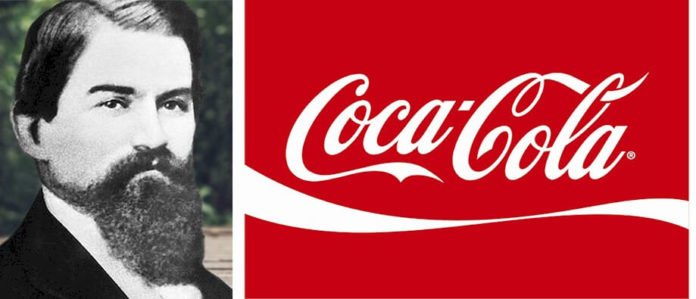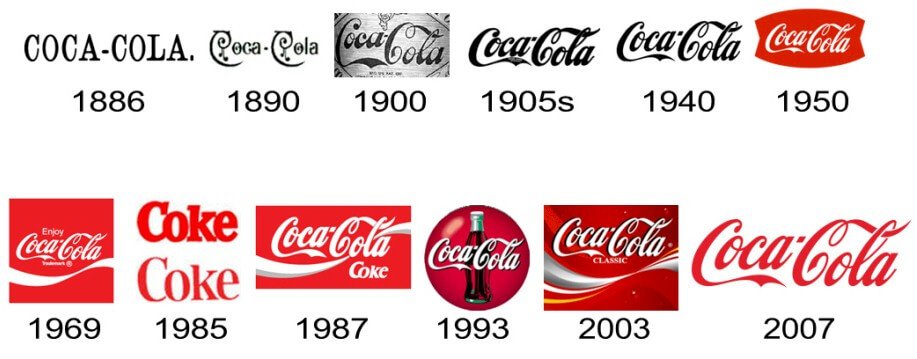Want to grab an ice-cold drink each time you happen upon the Coca Cola logo? It’s not only impressive but also well-marketed. This soft drink brand has a rich history.
As it’s popularly known, Coca Cola, or Coke, is a soft drink brand founded in 1886. Pharmacist and optometrist John Stith Pemberton is believed to have come up with the first recipe for the drink. But the Coca-Cola Company was founded by businessman Asa Candler, who purchased the rights to the brand in 1887. Candler was the one who started the mass manufacture of the beverage, making it famous the world over.
This Atlanta-born multinational has been expanding non-stop. In 2019, Coca cola’s raked in $37 billion in sales revenue, but their record sales revenue is even higher than that. Daily, Coke sells 1.9 billion beverage products all over the world.
Their logo has definitely played a crucial role in this growth. Since the company’s founding in 1886, its logo has gone through plenty of changes.
The Evolution of the Coca Cola Logo
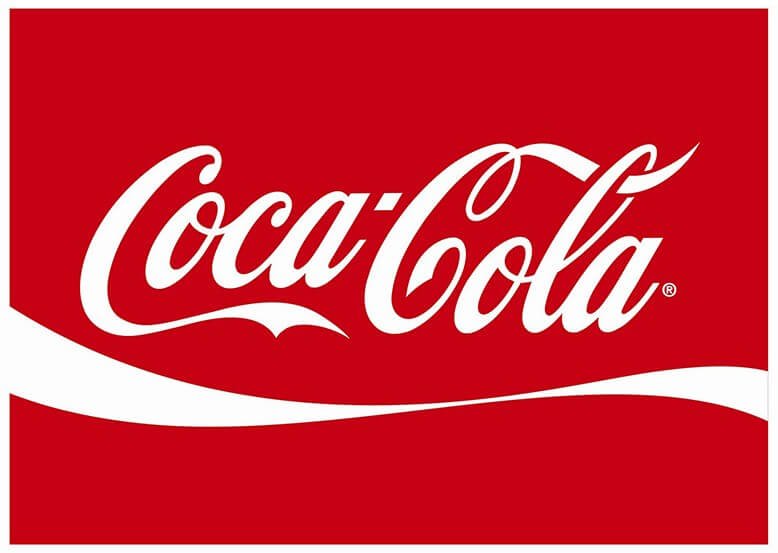 The Coca Cola logo is world-famous, and we all recognize it when we come across it. But this logo has undergone numerous changes since the first version was introduced. As the following timeline shows, the Coke logo hasn’t always looked like it does now.
The Coca Cola logo is world-famous, and we all recognize it when we come across it. But this logo has undergone numerous changes since the first version was introduced. As the following timeline shows, the Coke logo hasn’t always looked like it does now.
1886: The Beginning of Coke
John Stith Pemberton completes the recipe for his new beverage. His partner is Frank M. Robinson, who floats the name Coca-Cola hoping that the pair of first Cs would look great in advertising. Robinson tried writing the word “Coca Cola” in Spencerian script, a popular writing style back then.
1887: Coke Trademark Inserted
On the 31st of January 1893, the Coca Cola logo was trademarked. The word “Trademark” can be seen in the first C’s tail in the word Coca.
1890-1891: Coke adds More Swirls
For just a year, the Coca-Cola logo has a striking, swirly transformation.
1941-1947s: Coke Tail Modification
The phrase “trademark registered” is removed from the first C’s tail in the word Coca. Instead, the trademark is indicated under the logo. In 1947, the current Spencerian script we know today was trademarked.
1947-1960s: The Coke Red Disc
Coca Cola has used the Red Disc (button) symbol to advertise its drinks since 1947. The influential graphic image the disc shape offers became integral to outdoor signage. In the following year, the discs were hung outside places of business as both decoration and advertising.
1958-1960s: Coke Fishtail Logo
During this period, the script is placed in a shape that resembles an arch known as Arciform. In 1958, the Arciform sign (commonly called the “fishtail” sign) was unveiled. Within one year, the Arciform sign is used in signage, cartoons, copy, and vending machines.
1969: The Coke White Wave
Coca-Cola unveils the Arden Square emblem. In a red square, the Coca-Coca logotype is underlined using some “Dynamic Ribbon Device” or “White Wave,” which is still in use today.
1982: Diet Coke®
In the 1980s, Coca-Cola popularized slogans like “Coke is It!” and introduced Diet Coke in 1982. This was the first expansion of the Coke trademark. The famous logotype was altered to a type of serif font known as slab. The first Diet Coke logo included bold red letters on a white background.
2003: Coca Cola…. “Keeping It Real!”
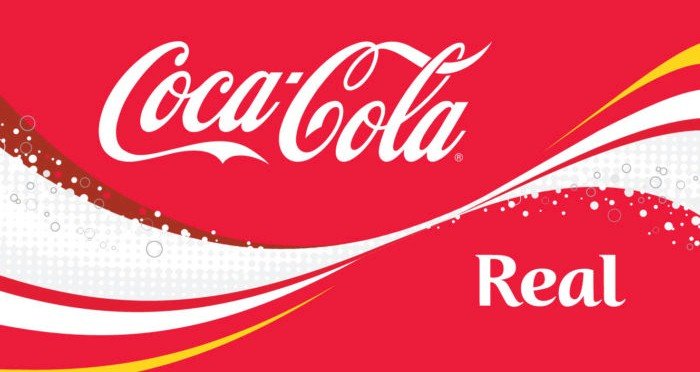 The launch of Coke’s “Keeping it Real” ad campaign saw the white wave embellished with some bubbles and a bit of yellow.
The launch of Coke’s “Keeping it Real” ad campaign saw the white wave embellished with some bubbles and a bit of yellow.
2007: Coke Classic Design
Altering the previous logo design, Coca Cola took a simple, bold approach with one white ribbon.
2011: 125th Anniversary. 125 Years of Joy
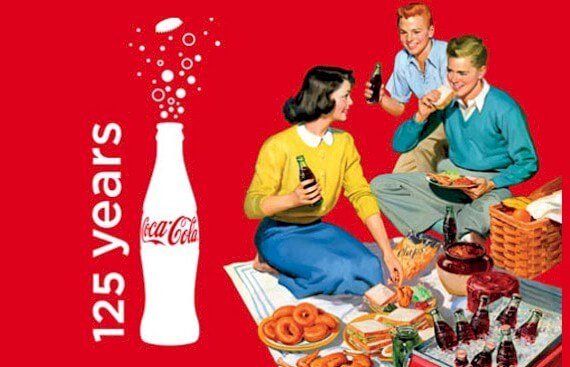
Coke’s 125th-anniversary logo sees bubbles escaping from the contour bottle. This is a salute to the past, present, as well as the future.
2013-2014: Write Your First Name in that Iconic Font
Coca Cola launched the “Share a Coke” ad campaign, which swapped the company’s logo for your first name. In the beginning, the words were printed in the classic “Coca Cola” Spencerian writing style. Due to trademark issues, the company created a brand new font inspired by the Coca Cola logo.
2016: Coca Cola… “Taste the Feeling”
Getting the best of both worlds, Coke’s “Taste the Feeling” ad campaign brought the company’s one brand approach to life, fusing the new with the old.
Instead of using different packaging for Diet Coke, Coke No Sugar, and Coca Cola Classic, all of the flavors came together under the traditional Red Disc logo style.
The latest Coca Cola logo design version emphasizes that all flavors belong to the Coca Cola family.
The Coca Cola Logo Design Elements
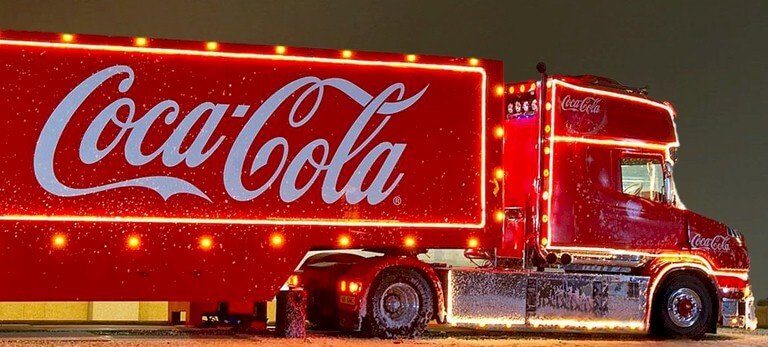 The Coke logo, like the trademark itself, is recognized worldwide. The distinctive design with cursive font and white swirl revive the spirit of youth.
The Coke logo, like the trademark itself, is recognized worldwide. The distinctive design with cursive font and white swirl revive the spirit of youth.
Coke Logo Shape: The Coke logo is in a circular or rectangular shape below the hobble-skirt bottle. The rectangular style is quite simple and features a swirl and a cursive font.
Coke Logo Color: The Coca-cola logo uses two colors only: white and red. Both colors appear vibrant on an otherwise simple design that captures the minds of young adults. The fonts are in white against a robust red background.
Coke Logo Font: The Coca Cola logo font is fancy and boasts a cursive look. Both first Cs look unique to each other. Beneath the font is a white swirl that highlights the logo’s simplicity and gives it a distinctive look.
The History of Coca Cola
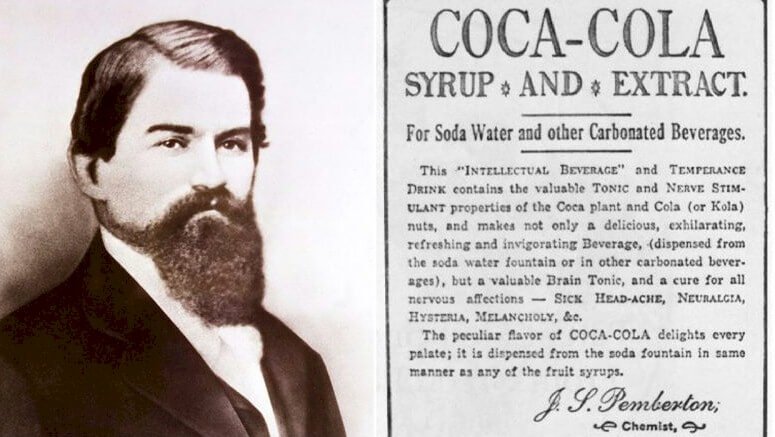 In May 1886, an Atlanta pharmacist and optometrist John Pemberton invented Coca Cola. According to the company, Pemberton formulated the syrup for Coca-Cola, which was tasted at Jacob’s Pharmacy in the neighborhood and passed fit for consumption.
In May 1886, an Atlanta pharmacist and optometrist John Pemberton invented Coca Cola. According to the company, Pemberton formulated the syrup for Coca-Cola, which was tasted at Jacob’s Pharmacy in the neighborhood and passed fit for consumption.
The syrup was mixed with water to produce a new tasty and refreshing beverage. Pemberton concocted the formula for the famed drink in a brass kettle at his home.
Coca Cola is Born
The name Coca-Cola was suggested by Pemberton’s accountant and partner Frank Robinson. Since the syrup’s recipe required the coca leaf extract and the caffeine extract from kola nut, it was easy to fashion the Coca Kola name.
But Robinson, who was excellent at writing with the pen, thought that using a pair of Cs in the brand would look impressive in advertising. Therefore, kola became cola, giving birth to the Coca Cola brand name. Robinson is also credited with writing the first Coca Cola script with the smooth letters that act as today’s popular logo.
On the 8th of May 1886, the Coca Cola Company sold its first soft drink to the general public at Jacob Pharmacy’s soda fountain in Atlanta. About nine servings of the beverage were sold daily. In the first year, the total sales were around $50. Obviously, Coke’s first year of operations wasn’t successful as Pemberton spent more than $70 to produce the drink, leading to a loss.
Coca-cola Expands
In 1887, another pharmacist and businessman from Atlanta, Asa Candler, purchased the Coca Cola formula for $2,300 from Pemberton. Sadly, Pemberton passed on a few short years later.
Towards the end of the 1890s, Coca Cola had become one of the United States’ most popular fountain beverages, mainly due to Candler’s relentless marketing efforts. With Candler now in charge, Coca Cola syrup sales increased by more than 4000% from 1890 to 1900.
While the company disputes this claim, evidence from their history shows that, before 1905, the Coca Cola beverage, which was sold as a tonic, may have contained extracts of caffeine from kola nut and extracts of cocaine. While cocaine was only declared illegal in 1914, Candler had started taking cocaine out of the recipe at the start of the 1900s. In 1929, all psychoactive elements of the coca leaf extract were eventually removed by scientists.
Advertising was integral to the success of the Coca Cola Company, and by the early 1900s, the beverage was sold all over America and Canada. At about the same time, Coca Cola started selling syrup to separate bottling firms licensed to sell Coke. Even today, the soft drink industry in the U.S. is run on this principle.
The Start of Bottling
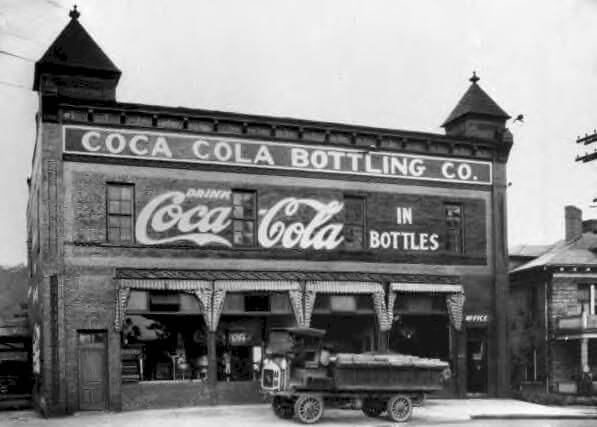
The promotion and marketing efforts of Coca Cola resulted in a considerable rise in demand. As such, Mississippi businessman Joseph Biedenharn started bottling the drink, making it movable. By 1895, Candler had set up syrup factories in many cities, including Los Angeles, Chicago, and Dallas, to cope with the rising demand.
While Candler was definitely business-savvy, he didn’t realize that Coca Cola’s future lay in portable bottles instead of soda fountains. Therefore, in 1899, Candler sold the sole rights to bottle Coke to two lawyers—Joseph Whitehead and Benjamin Thomas.
As the bottled form of the drink continued to grow in popularity, copycats started producing counterfeit Coke drinks. This prompted Coca-Cola to advertise its drink as genuine and run campaigns to ask the public to buy the genuine drink. In 1916, Coca Cola started manufacturing contour-shaped bottles. This classic bottle design enabled the company to differentiate between its product and counterfeits.
International Expansion
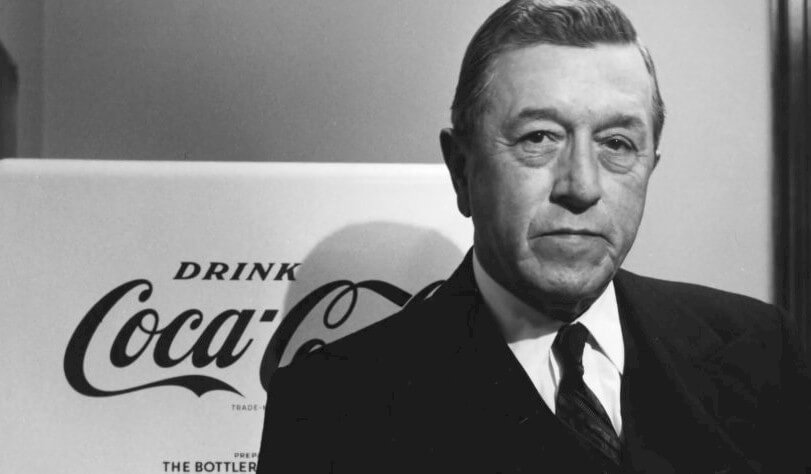 In 1919, Ernest Woodruff led a bunch of investors in acquiring Coca Cola. In 1923, Woodruff’s son Robert was named the company’s president. Robert Woodruff expanded Coca Cola and brought the company to the rest of the planet.
In 1919, Ernest Woodruff led a bunch of investors in acquiring Coca Cola. In 1923, Woodruff’s son Robert was named the company’s president. Robert Woodruff expanded Coca Cola and brought the company to the rest of the planet.
Coca Cola started distributing half a dozen bottles, encouraging people to buy the drink for consumption at home. In 1928, Coke was one of the sponsors of the Olympics, giving the firm even more worldwide exposure and launching a tradition that still exists today.
In 1941, America entered the Second World War, and this saw the demand for Coke by U.S. soldiers stationed overseas increase enormously. Under the stewardship of Woodruff, Coca Cola started constructing bottling plants abroad to meet the rising demand. In the mid-1940s to 1960, the number of nations with bottling factories nearly doubled, laying the groundwork for Coke to do business worldwide.
After the Second World War, overseas consumers of Coke requested more choices when buying the drink. Until the mid-1950s, Coke was marketed in a 6.5 oz. glass contour bottle. But the company finally started making bigger bottles in 1955 and finally metal flasks in 1960. In 1977, Coca Cola started producing their first two-liter plastic bottles.
Advertising Efforts
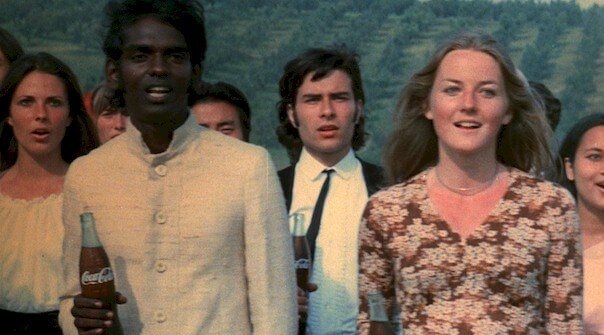
The Coca-Cola Company has always made advertising one of its key priorities. Throughout the history of the company, famous slogans and songs created the image of Coke as being an enjoyable and refreshing drink. In 1971, Coca-Cola released the famous ad “I’d like to buy the world a coke.”
Diet Coke
Under the new leadership of Roberto C. Goizueta, Coca-Cola introduced Diet Coke in 1982, becoming the company’s first trademark extension. Diet Coke was wildly popular, and in a few years, the product became the world’s most in-demand low-calorie soft drink. After Diet Coke’s success, Goizueta embarked on a mission to reformulate Coke and create a new flavor.
New Coke
After almost 100 years, Coca-Cola changed its formula for the first time and launched New Coke in 1985. During sampling tests, New Coke passed with flying colors, but customers demanded that Coca-Cola revert to the original recipe, which was re-introduced as Coca-Cola Classic. Ultimately, New Coke was halted in 2002 after underwhelming sales.
The Present and Future of Coca Cola
Today, as consumers around the world seek out new and fun beverage options, Coca Cola is finding new methods to tap into rising trends by investing in or acquiring fast-rising soft drink brands.
 In 2007, the North American wing of the company initiated efforts to look for and identify potential billion-dollar soft drink brands that Coca Cola can acquire. As such, the company has invested in or acquired brands such as Zico, Honest Tea, Core Power, and Suja.
In 2007, the North American wing of the company initiated efforts to look for and identify potential billion-dollar soft drink brands that Coca Cola can acquire. As such, the company has invested in or acquired brands such as Zico, Honest Tea, Core Power, and Suja.
Our Takeaway
Coca-cola and the Coke Logo is much more than a soft drink. The 19th century-born soft drink has come a long way from being a local soda fountain to being the most iconic refreshment in the United States.
Coca Cola, aka Coke, has had a long checkered history since its founding in 1886. The company’s ever-evolving story has spanned many decades—accustoming itself to the roaring 1920s era, the 1970s disco era, and eventually the current technology-driven modern era.
But in spite of the countless slogans, logos and promotional campaigns, the company has firmly stuck to its origins of happiness, fun, and enjoying the little pleasures of life.

